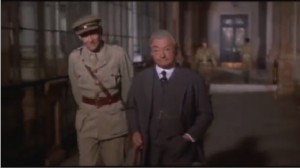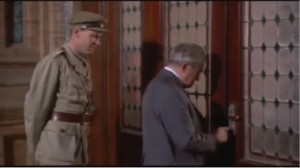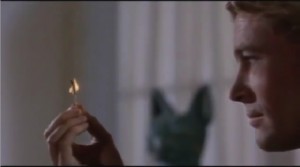Page 4 of The Mythic Roots of Western Culture’s Alienation from Nature. Adams and Belasco. Tapestry Institute Occasional Papers, Volume 1, Number 3. July, 2015. Outline / List of Headings available here.
The Hero’s Journey Myth in Lawrence of Arabia and Silverado
Joseph Campbell, who popularly and academically expanded upon Carl Jung’s original work with myth, identified the “Hero” as an archetypal, universal figure who engages in a “certain typical hero sequence of actions which can be detected in stories from all over the world and from many periods of history.” The sequence basically consists of leaving “the society that would have protected [him], and [going] into the dark forest, into the world of fire, of original experience.” There, the hero finds himself in unknown territory, facing stiff challenges that require courage and perseverance. His goal is to find someone who’s missing, locate and bring back a rare treasure of wealth or healing, or establish a new way of life that other people can follow. “The courage to face the trials and to bring a whole new body of possibilities into the field of interpreted experience for other people to experience—that is the hero’s deed.” The Hero takes his journey and engages in subsequent risky actions for three reasons. First, he is usually a young man who wants to seek adventure for the pure joy of that act. Second, he is often an outsider who doesn’t fit in and therefore has little to lose in taking risks that will better his lot if he succeeds. Finally, the Hero is often called into action by desperate pleas for help, usually because of injustice or dire need (19). All the basic elements of the Hero’s Journey Myth are visible in the sequence from Lawrence of Arabia we’re exploring.

You can hear a clear and very direct expression of the Hero’s adventure-seeking personality in the opening dialogue of the Lawrence of Arabia film clip we saw earlier: Lawrence eagerly and emphatically declares himself “the man for the job” before he asks rather casually what the job is. This dialogue clearly establishes Lawrence as an archetypal Hero about to set forth on a mythic Hero’s Journey. (Clicking the image on the right allows you to review just this portion of the video if you wish.)

The response to Lawrence’s question and the description of the job that follows outline the nature of this particular archetypal Hero’s Journey: he is to find someone (Prince Faisal), and to do it he will have to journey into a desert landscape that’s “a burning, fiery furnace” which “ordinary men” cannot survive. Lawrence’s response to all this is repeated statements that the task will be fun, a typical Hero attitude. And his superior’s rather disparaging assessment that Lawrence “is recognized to have a funny sense of fun” underscores the outsider position he occupies, which is also typical of the Jungian Hero. This scene ends at the important “match cut.” (You can review this part of the movie if you wish by activating the link in the image to the right of this paragraph.)

The famous “match cut” that follows literally transports the viewer from one world to another: from the halls of British bureaucracy to the vast sands of the Sahara. The initial scene of rising sun accompanied by somewhat disturbing music reminds us of the warning Lawrence has been given: the desert is a burning, fiery furnace that ordinary men cannot survive. This threat is highlighted at the end of the clip by the diminutive size of two men on camels who appear riding over the dunes, showing us how small and helpless humans are in comparison to the desert. (You can review this part of the movie by activating the link in the image on the right.)
While some key elements of the Hero’s Journey Myth are displaced from the opening sequence of Silverado, they are all still present in the film. As in Lawrence of Arabia, the Hero moves from inside a building into a vast landscape that becomes a burning, fiery furnace of a desert — one that’s clearly dangerous — even before the credits finish playing. In this movie, however, the Hero’s character and motives develop only after he reluctantly responds to calls for help from several different sources, and the Hero role winds up being shared among four characters. All four fit the Hero archetype as people who don’t fit into society, and the youngest manifests the extreme adventure-seeking traits typical of a Jungian Hero. Unlike Lawrence of Arabia, however, in which most of the film takes place in the desert, in Silverado most of the story takes place in town after the initial wilderness scenes. This is because the “Old West” is considered a suitable adventure landscape in American mythology, even in its towns. In fact, the lawless nature of many towns in “Old West” stories shows they exist outside the normal or ordinary “society that would have protected” the Hero from the trials he must face as part of the Hero’s Journey.
Continue to Next Section: The Role of Landscape in the Hero’s Journey Myth
— or —
Return to: Introduction and Outline / List of Headings
References, Notes, and Credits
for
The Hero’s Journey Myth in Lawrence of Arabia and Silverado
19. Joseph Campbell and Bill Moyer. 1988. The Power of Myth. Doubleday, New York. Quotes are from pages 138 and 41, respectively. and Donald Kalsched and Alan Jones. 1986. “Myth and Psyche: The Evolution of Consciousness.” An article “written. . . as a companion to a photographic exhibition at The Hofstra Museum, in New York City, November 15 – December 19, 1986. The exhibit was presented by The Hofstra Museum with The Archive for Research in Archetypal Symbolism (ARAS). The exhibit was curated by Karin Barnaby and Annmari Ronnberg.” Available online at the website for the C. J. Jung Foundation of Analytical Psychology, Inc., at http://www.cgjungny.org/d/d_mythpsyche.html. Accessed June 25, 2015.
